Farizon SV Review 2025
Farizon SV At A Glance
When it comes to launching a new brand, there’s often a lot of pomp and ceremony. And Farizon certainly hasn’t been quiet about its arrival in the UK. Designed as an electric van from the ground-up, the Chinese firm says its van is a class leader in many areas – but is it the best choice for you? Read our full Farizon SV review to find out.
First up, Farizon isn’t new – although it didn’t arrive in the UK until 2025. Indeed, it’s the biggest van company you’ve probably never heard of, having been the best-selling commercial vehicle brand in China for well over a decade.
It's part of the giant Geely group, which owns brands such as Volvo, LEVC and Polestar, so has experience with both electrification and with European-market vehicles.
The Farizon SV is its smallest vehicle. Rather than a car manufacturer that has upsized into making vans, the company has gone the other way – the majority of its vehicles are trucks and buses.
It also brings new technology to the market in the form of drive-by-wire technology, which controls the steering, brakes and throttle. This allows for more compact packaging and more space for the battery beneath the van’s body.
The Farizon SV it sits between the Ford e-Transit and the Ford e-Transit Custom in terms of size.
There are five different size combinations available initially: L1 H1, L1 H2, L2 H2, L2 H3 and L3 H3 configurations, each with an extra-low loading height of just 550 mm, which Farizon says is the best in class.
It also features an unusual side-loading arrangement. As there is no central pillar on the passenger side of the van, it gives a wide opening, albeit one of limited practicality for a panel van as the load bay retains a bolt-in bulkhead.
Also fitted as standard is a payload monitoring system, which uses ride-height sensors to calibrate the vehicle’s weight.
A payload read-out on the LCD driver’s display helps drivers to ensure that they are meeting gross vehicle weight regulations. Overweight loads are alerted to the driver. All are rated at 3.5t at launch, but Farizon hasn’t ruled out heavier versions in the future. Payloads vary by model, but range from 1160kg to 1350kg.
One of the key selling points will be the specification, which is extremely generous compared with rivals and includes a 360-degree Surround View camera, heated and ventilated seats for driver and passenger plus a heated windscreen. Other standard kit includes a heated multi-function steering wheel, high-power USB charging and air conditioning
Only one trim level will be offered, with a limited range of options including a 220v vehicle-to-load system with three three-pin plugs, a towing pack and 270-degree rear doors (the standard layout being 180-degree).
Three battery packs are available – 67 kWh or 83 kWh lithium iron phosphate (LFP) units or a 106 kWh nickel manganese cobalt (NMC) battery on the L3 H3 model.
In each case, the battery powers a 231PS motor with 336Nm of torque. The WLTP combined range varies from 177-234 miles depending on body style and battery pack, with the 67kWh L2 H2 offering the lowest of those figures and the 83kWh L1 H1 the best.
The SV gets a four-year, 125,000-mile warranty, with eight years of cover for the battery. As well as its developing dealer network, Farizon has an aftersales arrangement with the AA that offers technical support and repairs as well as 24-hour roadside assistance. A dealer network for the Farizon is currently being set-up with 18 retailers planned at launch.
With pricing that undercuts its main electric rivals and the specification on offer, it’s a tempting proposition for those ready to move across to a large electric van – although it remains a fairly small part of the market, for now at least.
Overall, the Farizon SV is a versatile van that’s good in many ways, but with a few minor flaws that let it down in others.
With a little more refinement and more of a focus on quality, Farizon looks set to be a strong contender in the electric van market and the Farizon SV is certainly a promising start. If the brand can focus on making its vans more harmonised to European tastes, particularly in terms of cabin quality, then it has a lot of potential to offer.
Driving the Farizon SV
Because the SV was designed from the outset to be an electric van, there was never any need for Farizon to design it to incorporate an internal combustion engine, freeing up space at the front end to house an advanced double-wishbone front suspension set-up of the kind often found on mid-engined sports cars.
It’s a juxtaposition to the double longitudinal leaf-spring at the rear, but nevertheless, it gives the Farizon SV quite a sharp handling set-up, while the drive-by-wire steering is direct and well-weighted.
The same can be said of the brakes, which are also progressive and have a natural feel – so it’s fair to say that the drive-by-wire technology in the new van doesn’t affect it negatively against more traditional mechanical systems.
That’s assuming long-term reliability, of course, but Farizon does say it conducted over a million miles worth of testing before the van was signed off for production.
We drove the Farizon SV both unladen and close to its maximum GVW, and in both cases it felt stable and had remarkably good ride comfort.
On the road, the electric motor is fairly quiet and, depending on drive mode, is quite responsive. You can choose between Eco, Normal and Sport drive settings and in the latter it becomes quite an engaging vehicle to drive, with a sharp throttle response, heavier steering and strong power delivery, but you’ll pay the price when it comes to the impact on the electric range.
In Normal mode, it’s a different van – not slow or unresponsive, but the change in character compared with Sport makes you wonder if the latter exists purely for reasons of showing off.
In day-to-day use, you’re unlikely to drive an electric van hard anyway and in Normal mode its no slouch, but the sharpness to its other controls disappears.
It’s not bad at all, though and certainly a match for smaller electric vans such as the Vauxhall Vivaro Electric and Peugeot e-Expert. Eco Mode will get you the best overall range, but it feels weedy and underpowered – fine for urban use, but you’ll likely want a bit more power on the open road.
We found some of the ADAS systems quite frustrating to use, especially the driver alert system, which uses a camera to focus on the driver. If you’re steering sharply, or manoeuvring on full-lock, the spokes of the steering wheel block its view and send it into a frenzied bing-bong.
The driving position is comfortable, although the manual seat adjustment is a bit fiddly. All-round visibility could be better, though, with thick windscreen pillars and small mirrors.
One area where the Farizon SV does suffer is with its turning circle, which at 14.0m for the L2 H2 is significantly worse than that of the Volkswagen Transporter or Ford e-Transit Custom – a side-effect of that double-wishbone front suspension, perhaps.
Both of these are partially offset by an excellent 360-degree camera system, but it’s nonetheless frustrating in a van that offers so much promise in other areas.
Farizon SV interior
There’s only one trim level for the Farizon SV, but you certainly can’t complain at the equipment on offer. The three seats are trimmed in faux leather and are both heated and ventilated – a feature that not long ago was reserved for the likes of a Mercedes-Benz S-Class.
Additional kit includes automatic air conditioning, a heated steering wheel, a heated windscreen and a smart 12.3-inch touchscreen with Apple CarPlay and Android Auto. It makes the spec of some European rivals feels a stingy.
It's all very well that it comes with all the toys, but there are areas where it lacks finesse and others that just look plain cheap.
Again, there’s a juxtaposition, with smart alloy-effect window controls and mirror adjusters, offset by some extremely low-rent plastics to the lower dash, and a glovebox lid that feels like it’s made out of Tupperware. It’s a shame, as the layout is stylish and, on the face of it, quite smart.
At the business end, all models come with a heavy-duty PVC floor that’s smart and neatly designed, with six or eight lashing points depending on body choice and the low load height of 550mm is the best in its class.
The maximum payload comes with the L1 H1 model with the 83kWh battery at 1350kg, and the lowest payload is 1160kg on the L2 H2 with the 67kWh battery.
Total cargo volume varies between 6.95 cubic metres and 13.0 cubic metres depending on model, with exact cargo dimensions to be confirmed.
One of the more peculiar features on the Farizon SV is its lack of a B-pillar on the passenger side. It delivers no particular advantage, as in panel van format the van has a bolted-in bulkhead, while at 1.0m wide on the L1 models, the aperture feels quite small – though it will (just about) accommodate a euro pallet.
In L2 form, the opening is 1.3m and is far more practical. Where the oddball side door may prove and advantage is in the future, should Farizon introduce a minibus to the UK market, or for converters where a platform cab or walk-through cab is preferable.
The load bay has conventional rather than LED lighting, while 180-degree opening rear doors are standard fit, with 270-degree doors offered as a £300 option.
Both battery packs use an 11kW onboard charger and will achieve a full charge at home in 6.5 hours (67kWh) and nine hours (83kWh), while both will take a 20-80% fast charge in 36 minutes, the smaller battery drawing a 120kW maximum and the larger one 140kW.
A towing pack is offered as an option, with a 2000kg braked trailer weight on each battery. A further extra is the availability of vehicle to load power, via three 220v three-pin plug sockets in the rear load bay, ideal for running power tools or other electronic equipment at the roadside.
Model History
February 2025
Farizon SV available to order in the UK
Jameel Motors UK has announced pricing and specifications for the all-new Farizon SV large van. It will include as standard a high level of specification.
An advanced drive-by-wire platform offers significant packaging advantages, with five different size combinations providing UK buyers with generous levels of cabin and cargo space. Available in L1 H1, L1 H2, L2 H2, L2 H3 and L3 H3 configurations, every model benefits from an extra-low loading height of just 550 mm.
The Farizon SV line-up includes the option of a 67 kWh or an 83 kWh lithium iron phosphate (LFP) battery, with a 106 kWh nickel manganese cobalt (NMC) battery available for the L3 H3 model.
All battery options feature advanced cell-to-pack technology, reducing weight while increasing battery capacity and body rigidity. One efficient, all-electric powertrain will be available, featuring a permanent-magnet synchronous motor with an eight-layer, flat wire configuration which produces 170 kW (231 PS) of power and 336 Nm of torque.
Optionally available are:
- Exterior paint finish (Cyan, Black, Blue, Gold and Grey): £550 + VAT
- Vehicle-to-load (V2L) system (220 v / 3.3 kW): £500 + VAT
- Towing package, fitted (crossbar, towball, towing electrics module): £400 + VAT
- 270-degree rear doors: £300 + VAT
|
Body configuration |
67 kWh |
83 kWh |
106 kWh |
|
L1 H1 |
£45,000 |
£48,000 |
- |
|
L1 H2 |
- |
£49,000 |
- |
|
L2 H2 |
£48,000 |
£51,000 |
- |
|
L2 H3 |
- |
£52,000 |
- |
|
L3 H3 |
- |
£53,000 |
£56,000 |


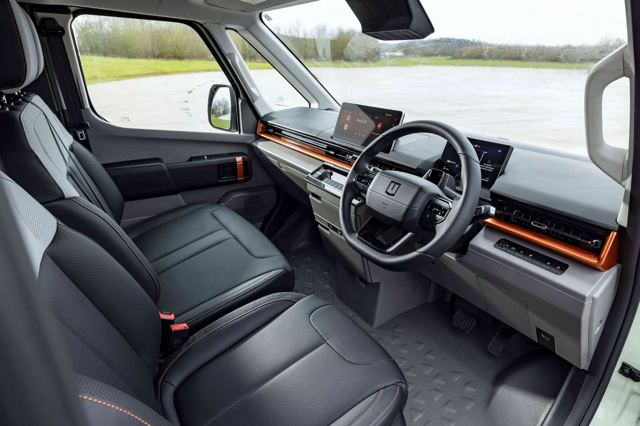
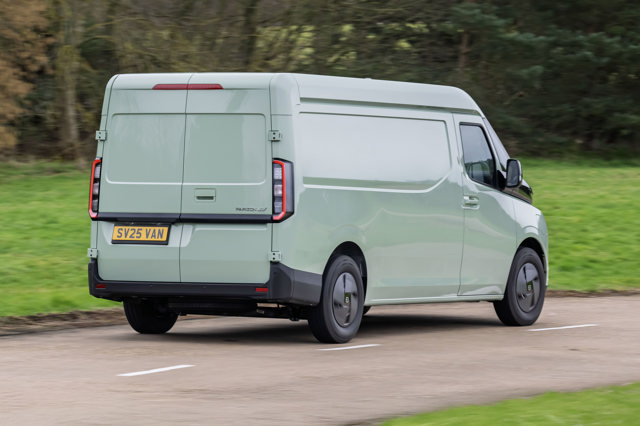
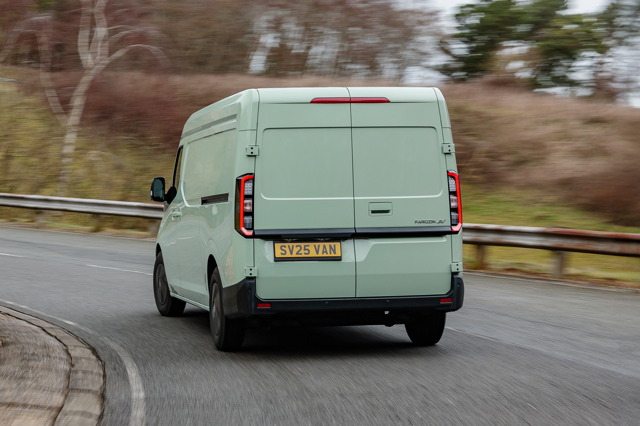
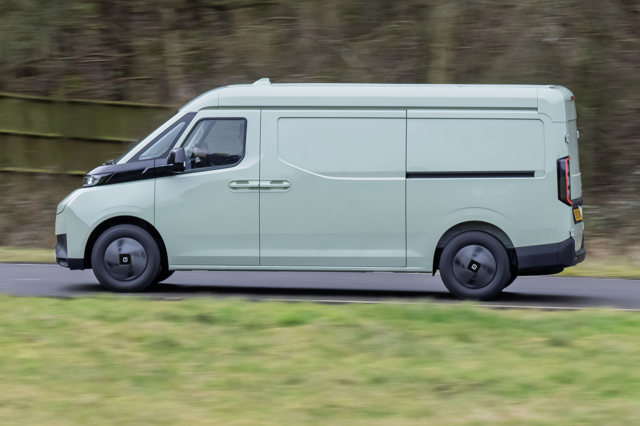
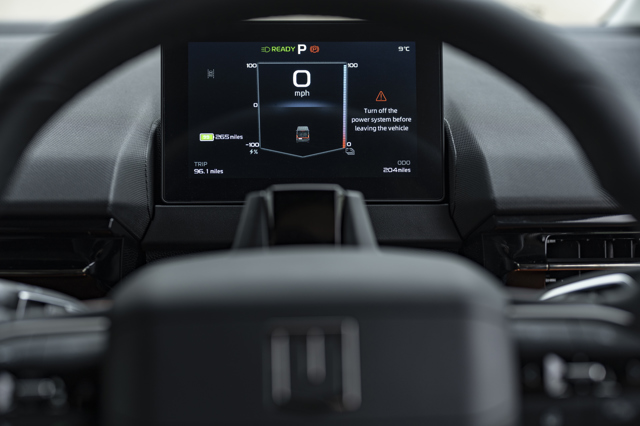
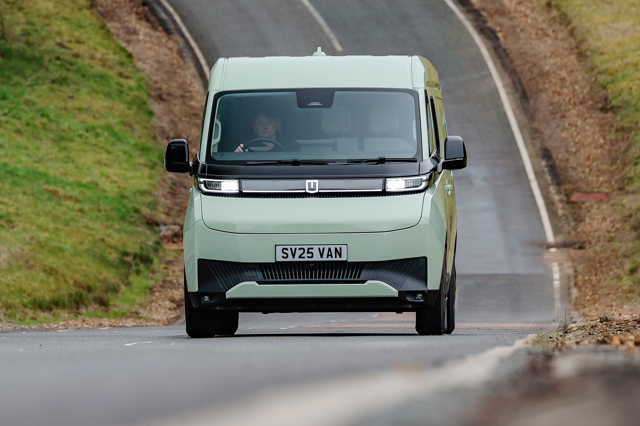
 Good payload, decent battery range, impressive ride and handling
Good payload, decent battery range, impressive ride and handling
 Some cheap-feeling interior plastics, fiddly touchscreen, poor turning circle
Some cheap-feeling interior plastics, fiddly touchscreen, poor turning circle